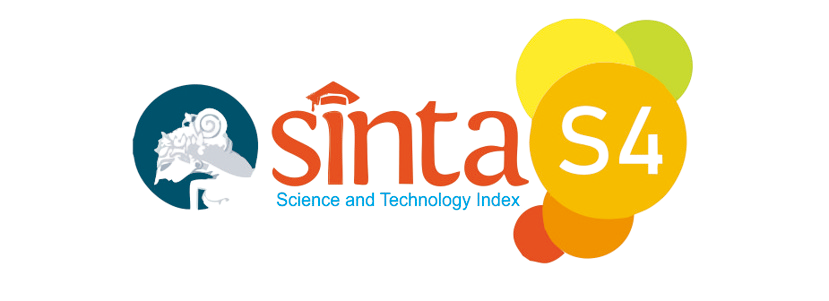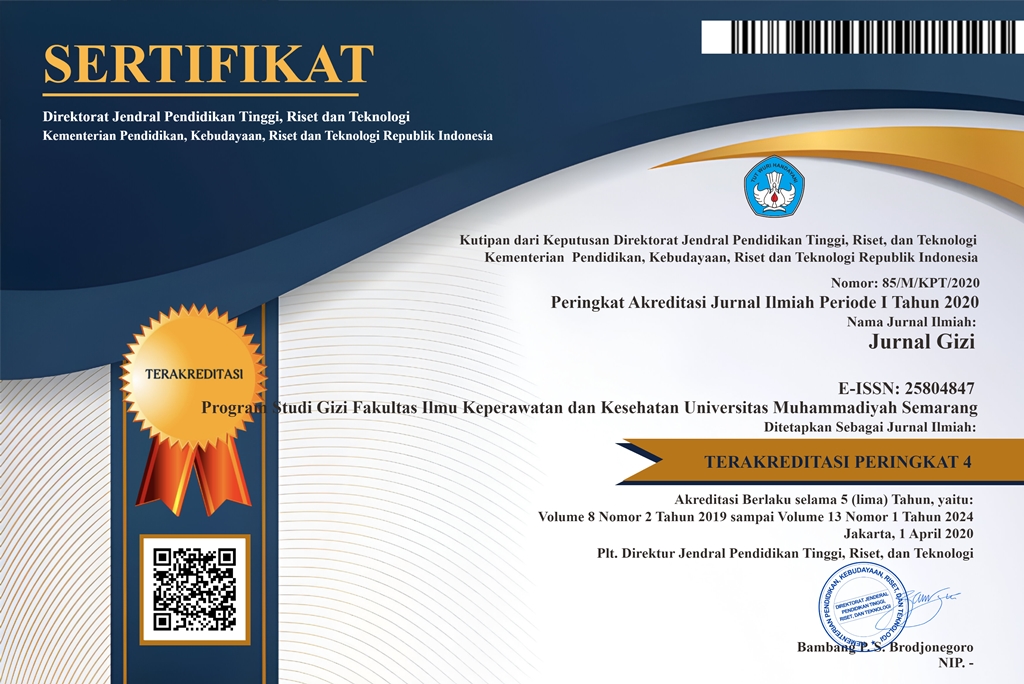Hubungan Konsumsi Bahan Makanan Sumber Vitamin C dan Vitamin E dengan Kadar Gula Darah Penderita Diabetes Mellitus Tipe 2 Rawat Jalan di Rumah Sakit Tugurejo Semarang
(1)
(2)
(3)
(*) Corresponding Author
Abstract
Diabetes mellitus is a series disorder or syndrome in which the body can not properly regulate the processing or metabolism of carbohydrates, fats, and proteins caused by either partial or absolute deficiency of the hormone insulin. The purpose of this study was Public Knowing the relationship intake of vitamin C, and vitamin E with a patient's blood glucose levels.
The research method explanatory research study with cross sectional approaced. The number of 27 samples consisting of hospital outpatient Tugurejo Semarang was taken by purposive sampling in accordance with the criteria The study starts from proposal writing to report writing from the month of January to August 2014. Univariate analysis performed to present the frequency distribution. Data normality test performed with the Kolmogorov-Smirnov test. The Spearman Rank correlation test use to bivariate analysis to examine the correlation between the dependent variable and the independent variables.
The largest proportion (26 samples or 59.3 %) of patients with type 2 diabetes mellitus in hospitals Tugurejo Semarang are female. The largest proportion(10 samples or 37.0 %) of samples are based on the age of 56-65 years old. The highest proportion of sample (19 samples or 70,4 %) have a elementary education. The highest proportion of samples (26 samples or 96.3 %) have the blood glucose levels is 126 mmHg and more. Intake of vitamin C in all samples is not sufficient. Intake of vitamin E in all samples is not sufficient. Statistical analysis showed a correlation between vitamin C intake and blood glucose level of Type 2 Diabetes Mellitus. There is no correlation between vitamin E intake with blood glucose levels of Type 2 Diabetes Mellitus.
The research method explanatory research study with cross sectional approaced. The number of 27 samples consisting of hospital outpatient Tugurejo Semarang was taken by purposive sampling in accordance with the criteria The study starts from proposal writing to report writing from the month of January to August 2014. Univariate analysis performed to present the frequency distribution. Data normality test performed with the Kolmogorov-Smirnov test. The Spearman Rank correlation test use to bivariate analysis to examine the correlation between the dependent variable and the independent variables.
The largest proportion (26 samples or 59.3 %) of patients with type 2 diabetes mellitus in hospitals Tugurejo Semarang are female. The largest proportion(10 samples or 37.0 %) of samples are based on the age of 56-65 years old. The highest proportion of sample (19 samples or 70,4 %) have a elementary education. The highest proportion of samples (26 samples or 96.3 %) have the blood glucose levels is 126 mmHg and more. Intake of vitamin C in all samples is not sufficient. Intake of vitamin E in all samples is not sufficient. Statistical analysis showed a correlation between vitamin C intake and blood glucose level of Type 2 Diabetes Mellitus. There is no correlation between vitamin E intake with blood glucose levels of Type 2 Diabetes Mellitus.
Full Text:
PDFArticle Metrics
Abstract view : 1875 timesPDF - 826 times
DOI: https://doi.org/10.26714/jg.4.1.2015.%25p
Refbacks
- There are currently no refbacks.
Diterbitkan oleh: Program Studi Gizi (D3 dan S1)
Fakultas Ilmu Keperawatan dan Kesehatan
Universitas Muhammadiyah Semarang
Sekretariat: Jl. Kedungmundu Raya No. 18 Semarang
Contact Person : Hapsari Sulistya Kusuma, S.Gz, M.Si (+62 85 6 41 536 553)

This work is licensed under a Creative Commons Attribution 4.0 International License.









.png)
.png)